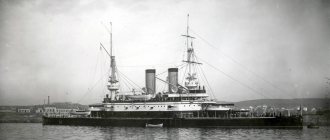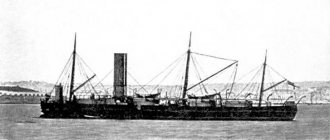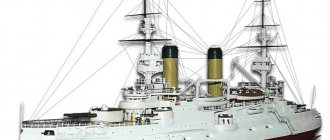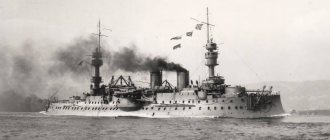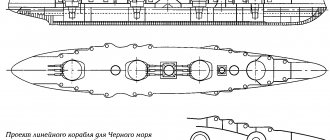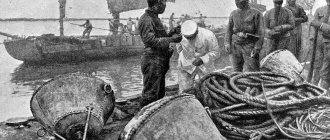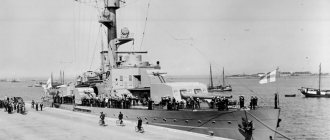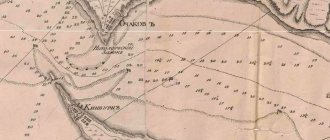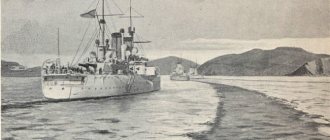The installation of engines on warships marked the beginning of the rapid decline of the sailing ship class. The invention of the explosive bomb by French Army Major Henri Pecsan in 1819 finally “finished off” sailboats. Experiments have shown the complete defenselessness of the most modern ships against the new projectile. With a successful shot, huge holes appeared in the wooden side and a large fire began.
The British-designed Warrior is the first all-metal battleship in history.
In 1860, the British built the first all-metal battleship “Warrior” in the history of shipbuilding, with a displacement of 9140 tons and armor 114 mm thick. This ship was at that time the largest warship in the world. The armament consisted of four 203 mm and 28 179 mm muzzle-loading guns, as well as four 20-pounder cannons. Along with the sails, a steam engine with a power of 5300 hp was installed on the ship. With. The speed reached 13.5 knots.
In appearance, the Warrior and the English and French battleships that appeared after it did not differ from sailing ships, only the pipes indicated the presence of a steam engine. Having become a model of shipbuilding for some time, the Warrior was never tested in a single naval battle.
Sailors of the British battleship installing a double-barreled machine gun designed by Gardner
In 1866, construction began on the large battleship "Captain" with a displacement of 7,770 tons. The ship was equipped with sails and a steam plant with a capacity of 5,400 hp. With. Four 305 mm guns were placed in the towers. “Captain” was supposed to become a full-fledged ocean ship, capable of making long journeys.
The first Russian turret battleship was the Peter the Great, with a displacement of 10,400 tons, which entered service in 1887. Four 305 mm guns were installed in the bow and stern turrets. There were also six 87 mm guns and two torpedo tubes. The thickness of the turret armor was 365 mm.
On ships of the "battleship" class, guns were covered with shields for the first time; later they began to build completely enclosed deckhouses
As a kind of response, the UK launched production of Collingwood-class battleships with a displacement of 9,600 tons. The armament in the form of four 305 mm and six 152 mm guns was supplemented by twelve 57 mm and three 47 mm Hotchkiss guns. There were also 13 five-barreled Nordenfeld canisters, two double-barreled Gardner canisters, as well as four 356-mm torpedo tubes. Reservations on the deck and hull ranged from 63.5 to 457 mm. The speed was 15 knots. This battleship became the first in the British fleet to receive rifled breech-loading main caliber guns.
One of the most characteristic ships of their class were the Russian squadron battleships of the Borodino type with a displacement of 14,440 tons. The first of them was laid down at the New Admiralty shipyard in 1900. Two steam engines with a total power of 16,300 hp. With. allowed to reach speeds of up to 16 knots. The thickness of the armor belt ranged from 145 to 283 mm.
British battleship Collingwood. The hull of a typical armored ship from the beginning of the era of ironclads was made on the basis of an old wooden steamship. A closed deck was installed in the middle of the hull, in which the guns were installed. The side wooden walls were inclined, like a hut. They were covered with steel plates up to 102 mm thick.
The main weapons were 4 cannons of 305 mm caliber, located in two closed turrets with armor up to 254 mm thick. The medium caliber included 6 twin turrets with 12 152 mm cannons on the sides. For protection against destroyers, there were twenty 75 mm guns, 10 per side, as well as 20 deck-mounted 47 mm Hotchkiss guns and ten Maxim machine guns, plus 4 381 mm torpedo tubes.
In general, these were modern and powerful combat vehicles that met all the requirements of the time. Four of these were built: “Prince Suvorov”, “Emperor Alexander III”, “Borodino” and “Eagle”. The fate of all four ships, like other battleships, was decided by the epoch-making Battle of Tsushima, which will be discussed later.
English battleship "Captain"
Russian armored ship of the Borodino class
Battleship "Peter the Great" of the Russian Navy
New in blogs
Battery battleship “Warrior”, England, 1861
Laid down in 1859, launched in 1860. Displacement 9140 tons, maximum length 128 m, width 17.8 m, depth 7.9 m. Machine power 5300 l. s., speed 13.5 knots. Armor (wrought iron): overhead line belt - 114 mm, traverses 114 mm. Armament (as of 1867): four 203 mm and twenty-eight 179 mm rifled muzzle-loading guns, four 20-pound breech-loading guns. 2 units were built: “Warrior” and “Black Prince” (1862).
Warrior has survived to this day. Operates as a museum.
https://klaaz.livejournal.com/92798.html.
For those interested, a photo of the preserved Warrior.
Battery battleship “Gloire” (“Gloire”), France, 1860
Laid down on May 1, 1858 in Toulon, launched on November 24, 1859, entered service in July 1860. In 1869 it underwent repairs and rearmament, in 1879 it was removed from the lists, dismantled in 1883.
Armament: thirty-six 164 mm muzzle-loading rifled guns . Since 1860 - 6 240 mm and 2 194 mm muzzle-loading rifled guns located in the on-board battery. Crew: 570 people. A total of 3 units were built.
Why didn’t they actually take so long to build them?
The idea of protecting “soft” and flammable wood with metal has been known in military shipbuilding for a very long time, at least since antiquity. Even then, in Syracuse in Sicily, the trireme Artemis was built for the tyrant Dionysius, the front superstructure of which was lined with copper sheets - of course, not for protection from shells (at that time, throwing machines were already used on ships - catapults and ballistae) , but from incendiary arrows.
In 1592 Korean naval commander Yi-sung, preparing to repel the Japanese invasion, ordered the production of a “turtle” ship (“kobukson”), the sides and deck of which were covered with metal sheets. Thanks to their “turtles,” the Koreans defeated the Japanese fleet and defended their independence. “Kobuksons,” according to surviving data, had a displacement of about 300 tons and were armed with 16 190mm caliber guns (shot weight 50 pounds) on the sides and four lighter cannons at the ends. They were driven either by 18 pairs of oars - unlike European galleys, the oars of these ships entered the water vertically and rowing with them was a series of rather intricate manipulations, or, in favorable weather, by mat sails raised on two low masts. These sails were controlled using ropes through special hatches in the deck, so as not to endanger people. They had a blunt-nosed hull, armor was carried out by bronze plates screwed to the sides and decks, and the deck plates also had a sharp spike - to make it more difficult for the enemy to capture the ship with a boarding attack.
According to historical data, the armor of the Kobukson even withstood fire from siege weapons. In the last, albeit victorious, battle with the Japanese, Y-Sun died, and rowing battleships were no longer built in Korea: there was no need, there was no longer such an enthusiastic inventor as, one feels, Y-Sun was, and low seaworthiness and the slowness of these floating batteries obviously did not inspire optimism in his followers as commanders of the Korean fleet...
In 1782, the Spaniards, preparing for the assault on Gibraltar, built several floating batteries, the sides of which were protected by copper sheets and cork shields. In addition, these ships were equipped with special pumps that doused the thick wooden sides with water so that they would not catch fire from hot cannonballs. True, all these tricks did not lead to anything meaningful, and the Spaniards once again suffered a crushing defeat.
Thus, despite the relative simplicity and apparent feasibility of the idea of booking, it did not spread for thousands of years. It’s time to ask not the question: “Why did people only think of armoring ships en masse in the middle of the last century?”, but the question: “Why didn’t they start doing this earlier?”
And the answer to this question is extremely simple: there was no point.
1. The wooden ship, for all its apparent vulnerability, had, thanks to the use of structural material with a density less than the density of water, an excellent reserve of buoyancy and extreme resistance to shelling by solid cannonballs. Suffice it to say that, for example, in the Battle of Navarino (1827), the Russian battleship Azov received 153 hits and at the same time remained combat capable until the end of the battle. A year later, the small Russian brig Mercury (20 guns) was attacked by two Turkish ships with a total of more than 180 guns, withstood prolonged shelling and returned to base on its own.
That is, throughout most of the history of military courts, a battle between them could be brought to a decisive outcome either by boarding or with the help of fire ships.
2. A wooden ship is quite cheap. From this point of view, it is easy to replace. Covering it with armor plates increased the cost by an order of magnitude, without significantly improving combat qualities: artillery had not yet played such a fatal role until the 19th century. At the same time, due to the increase in hull weight, the maneuverability, speed and seaworthiness of an armored ship would sharply deteriorate, which would turn it into an easy target for a boarding attack.
3. In 1822 The first iron-hulled ship, the Aaron Manby, was built in England. The sailing experience of this ship showed the promise of iron shipbuilding, which gave impetus to talk about the inevitable and imminent appearance of armored ships. Rumors about the emergence of similar projects in France, the USA and other countries increasingly reached Great Britain, the then “mistress of the seas,” which was very jealous of the primacy of its fleet.
Concerned by these rumors, the British decided on an expensive experiment: they sheathed the sides of the old sloop "Symum" with sheets of iron with a total thickness of 25.4 (1 inch; 4 layers of 6.35 mm each), and fired at it from ordinary ship 32-pounder cannons.
The effect was devastating. The cannonballs not only pierced the armor, but torn pieces of crushed iron so riddled everything inside the sloop and looked so terrifying that the famous English artillery officer G. Douglas, who was present at the tests, said that he would prefer to receive a neat “hole” from a bullet than a wound from such a fragment .
The experiment with Cymum put an end to the idea of armored ships for some time.
The revolution in naval artillery as an incentive to introduce armor on ships
Projects to improve the efficiency of smoothbore artillery firing spherical cannonballs have been known for a long time. For example, back in the 16th century, the inventor of logarithms, the Scottish scientist Napier, was tormented by the idea of how to force a core, after hitting the side of a ship, to change its trajectory, “throwing” around the ship, using up its kinetic energy more fully. But the idea of using explosive shells turned out to be more realistic. True, on this path a number of obstacles had to be overcome: a hollow spherical projectile could easily be crushed by powder gases even when fired. A solution was found in shortening the gun barrel. Thus, in the 17th century, mortars appeared - very short-barreled (1.5-2.5 caliber) guns that fired along a hinged trajectory. In the second half of the 18th century, almost simultaneously in Russia and England, unicorns and carronades appeared - short-barreled guns capable of firing explosive bombs flatly. Both unicorns and carronades were supplied to fleets in the hundreds, but in reality they fired, just like cannons, solid cannonballs: the industry of that time was simply not able to provide hundreds of naval guns with explosive shells, each of which cost 20-25 times more than an ordinary nucleus.
In 1819 French engineer Peksan developed the design of a large-caliber (220mm) gun capable of firing heavy bombs along a flat trajectory. Such a weapon could disable almost any wooden ship with just a few hits. The new Peksan made such an impression that similar guns are being adopted in all navies of the world: in England - with a caliber of 203 mm (8 inches), in Russia - with a caliber of 216 mm (8.5 inches). Such weapons began to be called “bomb guns.” Moreover, in Russia, starting from 1847, the construction of battleships (“Paris”, “Grand Duke Constantine”) began on the Black Sea, the deck of which was fully equipped with such guns instead of the 36-pounders standard for Russian battleships of that time.
In 1849, during the Danish-Prussian War, a coastal battery of Prussian bomb guns caused serious damage to two large Danish ships - the battleship Christian III (84 guns) and the frigate Gefion (48 guns). And although these ships died from fires that started on them, caused by hits from hot cannonballs, the participation of bomb guns in this battle played the role of good advertising for them. The Crimean War of 1853-1856 gave an even stronger impetus to innovations in maritime affairs. The destruction of a detachment of Turkish ships at Sinop by the Russian squadron, which included the Paris and the Grand Duke Constantine, and the heavy damage to the Anglo-French fleet during the bombardment of Sevastopol - all this raised the question of creating armored ships.
This topic has become all the more relevant in view of the rapid growth in the caliber of bomb guns - in England - up to 254 mm (10 inches), in Russia unicorns and bomb guns with a caliber of 245 mm and 273 mm appeared; in the USA since 1856 a series of large (about 4,600 tons) frigates were laid down, carrying up to 40 exclusively bomb guns with a caliber of 203 mm to 254 mm, and in 1857 the gigantic (about 5.5 thousand tons) Niagara was laid down, armed with 279 mm (11 inches) guns.
Mechanical revolution: the steam engine comes to ships.
The use of steam energy for mechanical purposes has been known since ancient times. Back in antiquity, the Syracuse scientist Hiero built a model of an external combustion engine, which was a hollow sphere mounted on an axis and equipped with inclined pipes located in a plane perpendicular to the specified axis. When the sphere was heated, the water poured into it boiled, steam escaped through the pipes and created a reactive force that caused the boiler-sphere to rotate.
Since the second half of the 17th century, on canals in England and France, cylinders installed on the shore with pistons running inside them, which were driven by the pressure of the steam entering the cylinders, were used to tow barges.
Finally, in 1784 English mechanic James Watt created the first working modern steam engine. Projects for using this device as a power plant for ships were not long in coming. In 1806, the American Robert Fulton built the first successfully tested steamship (Clermont; however, the engine for it was supplied from England). The vessel had a length of 40.5 m, a width of 3.96 m and a machine power of about 20 rated horsepower. In 1812 Fulton creates the first-ever combat steamer Demologos for the US Navy. It was a very large ship for its time (more than 2000 tons of displacement), built in the form of a catamaran. One of its buildings housed a steam engine, the other contained a supply of coal for it, the wheel was located between the buildings, and was thus reliably protected. The machine has a power of about 120 hp. allowed the ship to develop a speed of 5.4 knots during one of the transitions. "Demologos" was armed with 20 32-pound guns and had unusually thick sides made of strong oak - up to 1.5 meters! it was assumed that the cannonballs of that time would not be able to penetrate such a barrier.
The Anglo-American War was ongoing, and the Demologos was intended for the defense of New York Harbor; however, he did not have the chance to take part in hostilities. After the end of the war, she was used as a floating powder magazine and was destroyed by fire and subsequent explosion.
Starting from the second half of the 20s of the 19th century, the construction of steam ships - sloops, corvettes, frigates - became commonplace for military fleets. Moreover, if at first a paddle wheel was used as a propulsion device, then, starting from the 40s, an increasingly more successful type of propulsion device was the propeller; The transition from a paddle wheel to a propeller made it possible at the same time to increase the length of the onboard battery of ships - on paddle steamers, the paddle wheel and its casing noticeably limited the space for placing guns.
In 1847 the British first installed a steam engine on a battleship - the 74-gun Blenheim; under steam, this ship could develop about 6.7 knots. The experience turned out to be successful and soon the construction of screw battleships began in England and its eternal rival France. The French especially distinguished themselves in this matter: in 1849. they launched the 90-gun battleship Napoleon (5047 tons of displacement), which showed a fantastic speed of 13.5 knots under steam!
Bottom line: by the time of the Crimean War and during its course, ships equipped with steam engines showed significant tactical superiority over purely sailing ones. Thus, the serious superiority of the Anglo-French in steam ships practically paralyzed the activity of Russian squadrons in both the Baltic and the Black Sea, although in terms of the number of sailing ships the Russian fleet was at that time in second place, second only to the English.
But, having acquired a car, steam ships lost one of their former advantages: cheapness. Ships became expensive, and they had something to protect with armor: cars, boilers, expensive bomb guns, specialists to service all this. Finally, the development of European civilization by the middle of the 19th century led to a revaluation of the “human factor”, people became “expensive”, and military losses began to be perceived by public opinion more and more painfully.
The first armadillos.
The first battleships were built in France. Shortly after the first bombardment of Sevastopol, on September 5, 1854, Napoleon III ordered the construction of five floating batteries with a displacement of about 2000 tons - Lave, Tonnan, Devastation, Foudroyant and Congreve. These were wooden wide-hulled ships equipped with a steam engine and a screw propeller. Each of them was supposed to be armed with 18 Peksan howitzers. Remembering the British experience with the Cymum, the French decided to sheathe their sides with wrought iron slabs, which were very thick for those times - 100-110mm, and the deck - with sheets 25 mm thick.
Of the five batteries, only three were built; instead of 220 mm howitzers, they decided to arm them with more modern 195 mm bomb guns; Moreover, along special rails laid along the deck, all the guns could be moved to the embrasures of any of the sides.
As expected, the first battleships had scanty speed - only 3-4 knots, poor maneuverability and insignificant seaworthiness. Towing steamships in the fall of 1855. they were sent to the Black Sea. Sevastopol had been taken by that time; The Anglo-French fleet dominated the sea and carried out sabotage against various Russian ports and coastal fortresses.
So, in the second ten days of October, a squadron under the command of the French admiral Bruet was sent to capture the Kinburn fortress, which was armed with 62 cannons and mortars in a stone bastion and on earthen fortifications. All three floating batteries were also included in the squadron.
At dawn on October 17, the ships went to their positions. By 9 o'clock in the morning the first ironclads anchored opposite the Kinburn forts: Devastation just under 900 meters away, Lave 975 meters away and Tonnan 1,250 meters away. Before the battle, their decks were additionally covered with sandbags. At 9:06 the Devastation fired its first salvo; within half an hour he was joined by two other batteries and gunboats with long-range mortars, maneuvering at a considerable distance. The cannonade lasted almost 5 hours, during which time all three batteries fired 3177 cannonballs. Kinburn's fortifications were destroyed, almost half of the coastal guns were destroyed, Russian losses amounted to 45 killed and 130 wounded.
What about batteries? Their losses were minimal. "Devastation", which was closest to the forts, received 29 hits in the side armor - the cores of the most powerful Russian long-barreled 36-pounder guns left only one and a half inch dents; another 35 cannonballs and bombs failed to penetrate its deck. Only three cannonballs entered the battery: one through a poorly closed hatch and two through the gun ports, killing two and wounding 13 people.
"Lave" and "Tonnan" received approximately 60 hits each; on the Tonnan, 9 sailors were wounded. The impression made by the invulnerability of armored ships was so strong that the Russian commandant of Kinburn surrendered the fortress on the same day.
From the first experience of using armored ships, the French drew the right conclusions: the next step is the construction of truly seaworthy battleships. France at that time was ruled by the ambitious Emperor Napoleon III - the nephew of the famous Napoleon Bonaparte, who in 1795-1812 captured all of Europe except Great Britain and Russia, and, in the end, was defeated in the fight against them. After Russia's defeat in the Crimean War, the struggle with England, the most powerful industrial power of the time (up to 60% of world industrial production) and owner of the largest fleet, naturally rose on the agenda of the French Empire.
The emperor understood that to defeat the “mistress of the seas”, qualitative superiority was necessary. Being not only an august person, but also a person keenly interested in various military-technical innovations, Napoleon III went to any lengths of experiments in search of an anti-English miracle weapon - right up to experiments in the construction of rowing ships with a bow ram modeled on ancient triremes! But, in the end, the recipe was defined in two words: armadillos with rifled artillery!
During the Crimean War, rifled small arms demonstrated overwhelming superiority over smoothbore guns, and the question of creating rifled guns naturally arose. It was rightly assumed that such guns would have greater range, shooting accuracy and, thanks to the heavier elongated projectile, greater penetrating and destructive force on the target. During experiments in 1855-1857. The French managed to develop for the fleet a fairly successful muzzle-loading rifled cannon, the same caliber (164.7 mm) as the standard 30-pounder - the main weapon of French battleships and frigates.
The leading French shipbuilder of the time, Dupuy de Lôme, proposed building the ship entirely from iron, but the emperor was in a hurry, and it was decided to convert one of the wooden battleships under construction, La Gloire ("Glory"), into a battleship. The upper battery deck on it was dismantled, and the saved weight was used to install 120-100 mm iron plates, which almost completely covered the entire surface part of the hull. The result was a ship with a displacement of about 5,600 tons, with a speed of about 13 knots, armed with 36 rifled guns of 164.7 mm caliber.
Following La Gloire, the reconstruction of two more wooden battleships into battleships began - Invincible (Invincible) and Normandy (named after the province on the French server). And the next year, 1859. The construction of the first French iron battleship “Couronne” (“Crown”) begins.
British response
Even during the Crimean War, the French, based on the fact that the fight with Russia would be long and would require large expenses, handed over the drawings of their armored floating batteries to the British. According to which they laid down two series of similar ships: “Glatton”, “Meteor”, “Thunder”, “Trusty”, and after the battle of Kinburn - the slightly larger “Etna”, “Erebus”, “Terror” and “Tenderbolt”. The first two of them even managed to get to the Black Sea, but did not take part in the hostilities.
They did not make much of an impression on the naval leadership of the Foggy Albion: it was clear that due to poor seaworthiness and speed, such ships were not suitable for independent operations and required the same wooden ships to support the squadrons. And therefore they were considered only as a means for solving highly specialized problems.
In addition, the British conducted new experiments and were convinced that an iron 68-pound cannonball fired from a 203 mm gun with a 16-pound charge of gunpowder, from a distance of less than 400 meters, penetrates both 100 mm armor and the wooden substrate underneath, and the impact of a cast-iron cannonball leads to cracking of the armor plate.
Pacified by their conclusions, the Lords of the Admiralty ordered another portion of ship's oak for a million pounds sterling (the soaking and drying cycle is 20 years!). And the greater the effect was from the news of the construction of La Gloire in France. It became clear that the era of armadillos could not be postponed.
We must give the British their due: they began work on their first battleship with exemplary efficiency, energy and thoughtfulness. First of all, it was decided to build it entirely from iron. In terms of seaworthiness, it should not be inferior to wooden ships. To compensate for the weight of the armor, it was decided to increase the displacement to 9000 tons, since the new construction material allowed this (the strength of wood did not allow the construction of ships with a displacement of more than 6000-7000 tons, since they could collapse under their own weight).
True, it was not possible to book the entire freeboard of such a giant. And the British decided to limit themselves to a 114-mm armor belt extending approximately 2/3 of the length of the ship with traverses (transverse bulkheads) of the same thickness, and battery armor, also closed by traverses.
The armor plates were carefully processed and were connected to each other by means of “dovetails” that fit into the corresponding grooves of adjacent plates. One can imagine how difficult it was to install it in this way and adjust the 4-ton slabs, but the British coped with this task. True, it is believed that it was precisely because of the laboriousness of this operation that the first English battleship was delayed in launching for almost a year. The ends of the ship remained unprotected. Maintaining buoyancy was ensured by dividing the hold into a large number of compartments and having a double bottom along 2/3 of the ship.
When christened, the ship received the name "Warrior" - "Warrior". Since it was the first battleship in the world built of iron (the French “Couron”, although laid down earlier, entered service later), this circumstance gave the British the right to attribute to themselves the primacy in creating the “first true battleship.”
The use of iron as a structural material made it possible to significantly increase the length-to-width ratio compared to wooden ships and give the hull sharp contours. In combination with a powerful engine, this allowed the huge ship to show a record speed of over 14 knots during testing.
Initially, the Warrior was to be armed with 40 68 pound smoothbore guns, of which only 26 were located behind the battery armor, and the rest in the unprotected ends and on the open deck. But by the time the ship was ready, it was decided to leave only the 68-pounder guns that stood behind the armor on the closed battery, and install new rifled ones on the upper deck: 2 with a caliber of 178 mm (7 inches) - at the ends, 8 more of the same caliber - on the sides, and another 4 with a caliber of 127 mm, installed on the open deck, were intended for firing at small enemy ships, fireworks, repelling boarding parties, etc. It must be said that subsequently the ship’s artillery armament was changed several times due to the rapid improvement of artillery in the 60-70s of the 19th century.
The British began experiments with rifled guns almost earlier than the French, and first relied on the development of breech-loading guns. In the first half of the 60s, rifled guns with calibers of 3.5, 5, 6 and 7 inches were adopted by the British Navy. The latter had good ballistic characteristics and could throw a projectile weighing 110 pounds (about 50 kg) to a fantastic distance of over 8,000 meters at that time.
The Warrior was distinguished by its high quality of construction and was part of the active fleet and armed reserve for a very long time, almost three decades, and then was used as an auxiliary vessel. She was afloat even during World War II and was used as a blockade; currently preserved as a museum ship in Portsmouth.
In the image and likeness of the Warrior, another battleship was built, the Black Prince, named in memory of the English commander Prince Edward, who defeated the French during the Hundred Years War at Poitiers.
The First Arms Race: France vs England.
After laying in 1858. four armored frigates (that is, ships with one closed battery deck), the French, with their characteristic spontaneity, came to the idea that the next step should be the construction of armored battleships - that is, ships with two closed battery decks. In 1859 The laying of the first pair of such battleships takes place, named in honor of victories in the recently ended war with Austria - “Solferino” and “Magenta”. Their displacement increased by more than 1000 tons, the number of guns increased by one and a half times, but no qualitative breakthrough was achieved: these were still the same wooden battleships, lined with slabs of forged iron 110-120 mm thick, armed with the same rifled 164, 7 mm cannons and 195 mm smoothbore. The only innovation was steel 14-ton rams protruding 3 meters from the stems of the new battleships - after all, Napoleon III’s experiments with triremes had an impact!
All of these six armored ships were being built safely, but the French were not going to slow down, and soon after the laying of La Gloire, Dupuy de Lom came up with a grandiose proposal: to build 10 more similar battleships in just a year and a half! At the end of 1860, the emperor approved this program; however, after a year and a half, the overlay came out: laid down in 1861-1863. “Provence”, “Flandre”, “Mananim”, “Savoie”, “Guienne”, “Revenge”, “Surveillant”, “Valerez”, “Eroin” and “Galoise” entered service only in 1865-1867. (progress compared to the first-born of armored shipbuilding was expressed only in the fact that the Eroin, the only one in the entire series, had an iron hull).
But for the British this was little consolation: in 1862, when their second battleship “Black Prince” entered service, the French had 6 seaworthy battleships! Ratio 1:3! It seems the fate of the island power hangs in the balance! So what about the British?
Having noted the main drawback of the Warrior - the lack of armor at the ends of the hull, they corrected it on the one laid down in 1861. "Achilles", whose displacement is close to 10,000 tons. Also in 1861. The British lay down three even larger battleships - the Minotaur, Egincourt (this is how the name of the French village of Agincourt is pronounced in English, near which the British defeated the French during the Hundred Years War) and Northumberland. They are another 1000 tons larger than the Achilles and the thickness of their armor has been increased to 140 mm. To give them the ability to move under sail (high autonomy of warships was one of the main requirements of the admirals of the empire scattered across five continents, but the machines could not yet provide the required cruising range), the designers equipped these monsters with as many as 5 masts. However, from the moment the sails were raised until the Minotaur began to move, about 40 minutes passed: it is clear that they were unimportant sailors, and maneuvered even worse.
If Achilles entered service in 1864, then Egincourt only in 1867, and the last two giants only in 1868.
However, even during the years of construction of the Warrior, the British realized that such ships, firstly, were too expensive, and, secondly, Britain, with all its industrial power, building such giants would not soon overtake France in the number of battleships. Therefore, immediately after the first pair of ships of the “Warrior” type, the British laid down another pair of battleships of smaller displacement - “Defence” and “Resistance” (“Protection” and “Resistance”), approximately identical in their parameters to the French battleships of that time, but with unprotected , as on the Warrior and Black Prince, with extremities. Two dozen smooth-bore 68-pound guns stood on them on a closed battery, and another 4 more powerful rifled 178-millimeter guns - in a “diamond” formation (two at the ends, two at the sides) - on the open deck.
In 1862 The Admiralty announced a competition among private firms to build two more battleships in the image and likeness of the Defense; This is how “Hector” and “Valiant” (“Valiant” - “Powerful”) appeared. An interesting feature of these ships was that they were, perhaps, the only battleships in the history of world shipbuilding whose upper belt (battery protection) was longer than the lower one (waterline protection). This absurdity is explained quite simply: the admirals still demanded maximum seaworthiness from ships, easy climbing on waves, which required making the ends as light as possible. So the belt on these two battleships extended only 65 meters with a total hull length of more than 85 meters.
"Defence", "Resistance", "Hector" entered service in 1864, but the construction of "Valiant" dragged on until 1868.
In 1861 In England, it became known about Napoleon III’s decision to build 10 Provence-class battleships at once, and then the British decided to follow the “French path”: in parallel with the construction of purely iron battleships, they rebuilt the wooden battleships that had begun construction into ironclad ships. For this purpose, 8 ships were selected at once: one class I battleship (131-gun) - laid down back in 1849, Royal Sovereign, and 7 - class II (91-gun) - Royal Oak (year of entry into service – 1863), “Prince Consort” (1864), “Caledonia” (1865), “Ocean”, “Ziles” (1866), “Royal Alfred” and “Repulse” (1870). And if the restructuring of class II battleships was not anything extraordinary: wooden hulls were sheathed with 114 mm armor (the ends were armored with 76 mm thick plates) and armed with a different number of 178-203 mm guns, then a completely different fate awaited the Royal Sovereign. They decided to convert it into a tower ship. In connection with this, the two upper battery decks were not completed, but 4 round towers appeared above the main one, carrying 5 powerful guns (the bow was a two-gun one). All the towers stood in a diametrical plane and its entire battery could fire on each side of the Royal Sovereign.
This experiment seemed successful to the British, and before 1866 they built another similar ship, but entirely made of iron - the Prince Albert.
In addition to the reconstruction of these 8 wooden ships into battleships, in 1863. The British laid down two battleships with wooden hulls of a special design - “Lord Clive” and “Lord Warden” (they entered service, respectively, in 1866 and 1867. But by that time the time had already come for other ships: in the same 1867 in Bellerophon, the first battleship of the new generation, entered service...
However, while on opposite sides of the English Channel the British and French were anxiously calculating the number of battleships, the number of guns and inches of armor on them, on the other side of the Atlantic a war was unfolding in which battleships had already become one of the main forces, and their number was not measured in units , but in dozens.
USS Monitor. The first real armadillo.
Py.sy. I highlighted rifled muzzle-loading guns in the captions because, essentially, for 10 years all fleets that used rifled muzzle-loading guns were virtually unarmed. The guns were extremely unreliable, low rate of fire, etc. In the event of a real battle, there could well have been a catastrophe—the complete unsuitability of large artillery. For example:
Information about the ineffectiveness of British naval artillery periodically leaked into the English press. At the end of 1869, the newly commissioned battleship Hercules sailed into the Atlantic. Its displacement was about 9,000 tons, the main caliber consisted of eight Vulich 10-inch (254 mm) muzzle-loading guns placed in a casemate. Off the coast of Portugal, during the first practical firing, six of the eight guns failed. I would like to add that during practical shooting they usually shoot with practical (half) loads.
The London Army and Navy gazette of January 15, 1870 wrote: “The guns of our most powerful battleship are rendered useless by their own shells.” This is the action of zinc protrusions!
How it all began
The ship was laid down in December 1861, launched on May 18, 1863, after July sea trials, due to another aggravation of relations between the two empires, it was hastily transferred to Kronstadt, having a number of deficiencies.
It is officially believed that the order of the first armored ship was entrusted to the most likely enemy, since domestic engineers had no experience in building such ships - however, no one had it then, so the financial background of the issue is shrouded in the darkness of the unknown, formally the cost of the ship was about a million rubles.
Battleship "Perbornets" at the shooting range
Service of the first battleship
In 1864, the ship was included in the defense system of the Gulf of Finland, in addition, it had the specialization of a “manpower forge” for the Baltic Fleet, so during 41 years of its service it never left the water area of the same name.
The only high-profile incident with his participation occurred off the coast of Albion, when a prowling battleship rammed a floating hospital, but the tragedy was then avoided. On 12/12/1905 it was withdrawn from combat service and, according to some sources, it was used as a blockade almost until the 1960s, apparently having wasted an entire century.
Blokshiv - a vessel used as a floating premises for the most necessary purposes, usually without its own propulsion.
Armadillo "Don't touch me"
"Don't Touch Me" (1865)
It became a variant of the battleship "Pervenets", the difference was that the ship was initially planned to be armed with eighteen 203-mm rifled and four 87-mm guns, which required more space, so some changes were made to the design of the freeboard, and its armor was also strengthened.
Since the number of barrels was eventually reduced, the ship's displacement was only 3,500 tons, a 1,200 horsepower steam engine propelled it to a speed of 8 knots, indicating worse hydrodynamics than the prototype.
Just like the “Firstborn”, it performed the functions of defending the northern capital from the sea, and therefore did not take part in any military actions. But he became the culprit of a couple of accidents, confirming the prowling reputation of these ships, in 1869 he collided with the frigate Petropavlovsk, and fourteen years later he seriously crippled the Norwegian Hayden.
Yaw is instability on the course due to small disturbances (poor controllability).
In 1895, the ship was “demoted” to a block at the Mine School, ten years later it was excluded from the lists of the fleet, and in 1908 it was sold to private owners for use as a barge. After the revolution, she served the needs of the Leningrad port and the metal plant of the same name, and was sunk by the Germans during the blockade. In 1950, it was raised and cut into metal.
Battleship of the Russian Empire "Don't touch me"
"Kremlin" (1867)
The last battleship of this type had a used steam engine from the frigate "Ilya Muromets", which, as a result of the bulkhead, developed a power of about 1000 horsepower, which allowed the ship to reach a speed of 8 knots.
Armament was originally seventeen 196 mm and four 87 mm guns, and the hull had only minor changes, resulting in a standard displacement of only 3,400 tons.
Like its sisterships, the ship spent the entire period of its long service in the Baltic, becoming a true “poor bearer” of the Russian Imperial Fleet. His first “merit” was the sinking of the frigate “Oleg” - on August 3, 1869, the armored squadron of the Baltic Fleet worked out evolutions together with more ancient ships. As a result of the fact that the Kremlin, which had lagged behind the formation, was in a hurry to take its place, a dangerous rapprochement with the said frigate occurred.
Evolution is a maneuver in which, when a detachment of ships moves by sea, a change occurs in their formation.
As you remember, the “Firstborns” were distinguished by yaw - the crew could not cope with the controls, and the battleship drove its stem equipped with a ram into the co-voyager right under the midships. Having flown onto the rocks twice before, he simply could not “miss” such an opportunity and after a quarter of an hour he lay down on the ground, taking sixteen crew members with him.
Midship is a section of the ship located exactly in the middle perpendicular to the movement.
Battleship “Kremlin”
However, the “Kremlin” itself was distinguished by its suicidal character, which it demonstrated in May 1885, while performing its “Tallinn crossing”. As a result of a storm so strong that old-timers, of course, had no analogues, he damaged the car and began to take on water.
It was decided to wash up on the sandy shore in the Kunda area, where the ship, let’s say, “lost its buoyancy.” Subsequently, he was raised and reinstated in Kronstadt, since his further service was not distinguished by excesses, it can be assumed that he satisfied his craving for adventure. 10/12/1905 “Kremlin” was withdrawn from the fleet, and three years later it was scrapped.
Evaluation of the first battleship project
I note that although the Firstborns are considered the first Russian serial battleships, in fact they were floating batteries that were supposed to support the forts of Kronstadt with fire when a potential adversary tried to break through between them to the northern capital.
The low speed compared to the battleships of the same British did not allow them to hope for success in battle as part of a line, thus, their artillery and rams could work effectively only in narrow areas where the enemy could not realize their speed advantage.
It is no coincidence that they were subsequently reclassified as coastal defense battleships, which indirectly emphasizes their very limited range of applications. As a result, we have to admit that these were not the most successful ships, which became only a stepping stone towards the creation of more advanced battleships.
Description of design
A battery battleship with a standard displacement of 3,600 tons, equipped with a steam engine with a capacity of 1,060 horsepower, reached a speed of up to 9 knots. The side armor was made of British 114 mm forged plates, they also protected the conning tower, the cheekbones and shells were covered with 102 mm plates.
Artillery armament was initially represented by domestic twenty-six 196-mm and four 87-mm guns, but was subsequently changed several times. According to the theories of that time, the ship's stem and sternpost had ram projections. The crew consisted of 18 midshipmen and officers, as well as 414 “lower ranks”.
The sternpost is a powerful beam at the stern of the ship, in fact its end. A steering feather (plate) is attached to it to control turns.
The stem is a reinforced beam at the bow of a ship, connected to the keel.
Armored battery "Pervenets"
